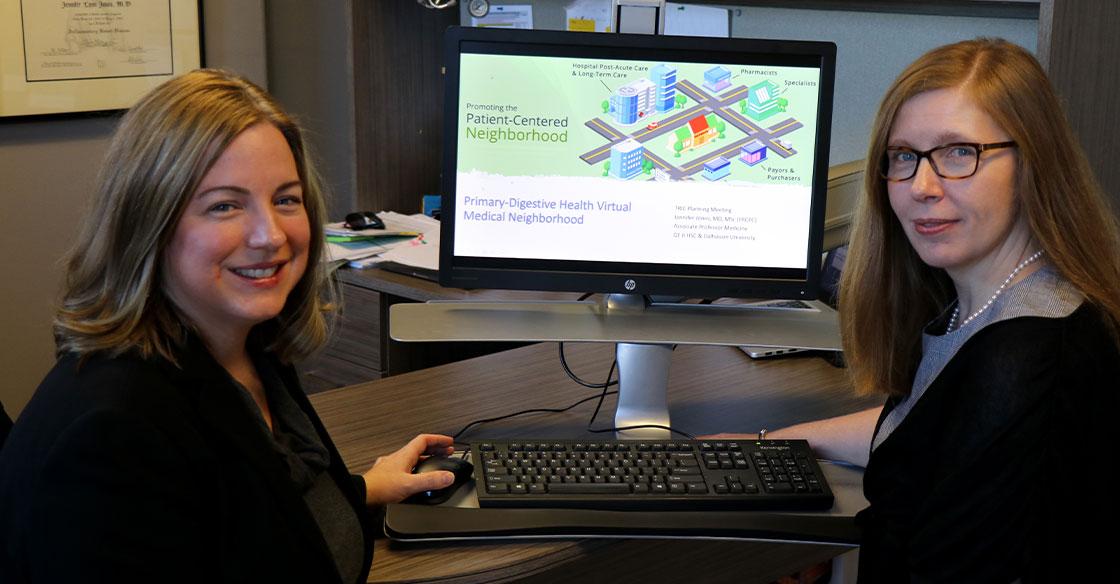
Originally posted on qe2times.ca.
It is often a daily challenge for the 20 million Canadians living with gastrointestinal (GI) conditions. Unfortunately, help can take years depending on the type and severity of their condition. But at the QEII Health Sciences Centre, two gastroenterologists recognize the challenges that Nova Scotians with GI conditions face and are determined to change the status quo when it comes to referrals, wait times and access to treatment options.
Dr. Jennifer Jones recently received a QEII Foundation Translating Research Into Care (TRIC) grant to help launch their pilot study, The Virtual Gastrointestinal Primary Health Medical Neighbourhood. The Virtual Medical Neighbourhood (VMN) is a model for providing integrated healthcare delivery between primary healthcare providers and specialists through an online tool, allowing them to collaborate and implement evidence-based, best practices in more remote locations. Dr. Jones says the model is perfect for Nova Scotians.
“One in 83 Nova Scotians have Inflammatory Bowel Disease (IBD) compared to one in 160 in the rest of Canada,” says Dr. Jones.
The idea for the QEII’s study builds on a concept that initiated in the United States that has since provided useful data for how this program can successfully support access to care for patients.
“In an area like Nova Scotia, where there is geographic variation in access to care and resources, the question is: ‘How are we able to integrate how we care for patients more, so we are changing the traditional referral routes and providing the right care for the right patient in the right place and at the right time?’”
Currently, most referrals for GI conditions come from primary care physicians within Nova Scotia Health Authority’s Central Zone, explains Dr. Williams. She adds they do receive referrals for complex disease from across the province.
“Over the last five years, we have seen the wait times for patients increase. We are doing our best to streamline the triage process so we make sure the referrals we are seeing are those who will benefit most,” says Dr. Williams.
As the provincial site for advanced endoscopy and the multi-disciplinary IBD team, she says there are certain patient populations that can only be cared for at the QEII, which means they not only see these patients, but also all of the referrals from primary care physicians.
“It is estimated that as much as 20 per cent of primary care physicians’ practice may be comprised of GI conditions,” says Dr. Jones.
The current referral model involves generating a paper-based referral to initiate the process, then waiting to receive a set of paper-based recommendations, which she says is not working for GI patients. With the support of NSHA’s Information Management & Technology team, the pilot will look at the feasibility of rolling out a VMN in which a gastroenterologist can directly connect with primary care physicians, nurse practitioners and other allied health professionals in real time, using special software, to implement more efficient diagnostic and management approaches.
Dr. Jones says they chose the Westville Medical Clinic in New Glasgow as the trial clinic based on its documented need as an underserviced area for GI specialty services. Dr. Aaron Smith will head the trial clinic, which has four primary care physicians, two nurse practitioners and a clinic nurse. With more than 7,000 patients, it is expected to provide valuable data the team hopes will address some of the concerns and barriers physicians and patients face.
“Involvement in this project is exciting for us at the Westville clinic, says Dr. Smith. “As a primarily rural clinic, our clinicians are often challenged to ensure that our patients’ medical needs are addressed effectively.”
“GI issues are one of the main reasons we see a significant number of our patients,” he continues. “Our geographical area has had challenges in meeting our patients’ clinical needs in this regard.”
Innovation in health service delivery and effective use of technological support, such as VMNs, are key factors in improving the health outcomes of Nova Scotians.
Through the VMN, physicians can also access clinical-care algorithms for common, routine GI conditions. “For example, if you had a patient with GI tract symptoms, there would be a standardized approach to diagnosing and treating them. By following the plan, the physician would be confident about the diagnosis and whether the patient should be coming to the QEII for treatment or if they can be treated locally,” says Dr. Jones, who adds that a study in Calgary that returned routine GI referrals to primary care physicians with a set of comprehensive clinical care instructions reduced referral times for routine GI conditions by more than 80 per cent.
Dr. Jones is hopeful the pilot will result in reduced wait times, decreased delays in diagnosis, improved access to therapy, and ultimately, improved outcomes for various GI conditions, along with a reduced overall cost to the system.
And if all goes well, Dr. Jones and her colleagues are confident this type of evidence-informed system transformation could eventually be customized and adopted by other chronic disease clinics.